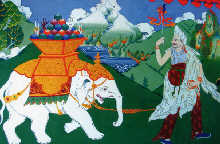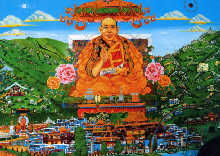 An ordinary rural area with high mud walls and narrow lanes, Tongren would be totally unremarkable were it not for the fact that almost every house can lay claim to a resident artist of some repute.
An ordinary rural area with high mud walls and narrow lanes, Tongren would be totally unremarkable were it not for the fact that almost every house can lay claim to a resident artist of some repute.
 Characteristics of Regong art
Characteristics of Regong art
In the early period, Regong artworks were crude and unsophisticated with monotone colors, featuring typical Indian and Nepalese styles. In the mid-17th century, artisans mastered better techniques and the painting styles became more elegant and exquisite; they also paid more attention to decorative effects in their works. Thus, the art entered a prosperous period of development.
The 19th century was the heyday of Regong art, when gold, silver, pearl, agate and other precious stones found their way into the works, featuring beautiful colors and an exquisite touch. The artisans of this period paid special attention to the decorative interest in their works and employed a great amount of gold to make the works resplendent and magnificent, creating an ardent atmosphere. The works not only look harmonious in their arrangement of different subjects, but also are lifelike and lively, displaying outstanding artistic effects.
Over the past several centuries, Regong art artisans traveled to many different regions to create different works, such as Qinghai Province,Tibetan Autonomous Region,Gansu Province,Sichuan Province, the Inner Mongolian Autonomous Region and other places in China, as well as India, Nepal, Thailand, Mongolia and other countries in the world, leaving behind numerous exquisite art works. They assimilated artistic nourishment from Tibetan paintings,Dunhuang murals, and foreign similar works and then combined them with local folk arts of Qinghai Province to gradually consummate the techniques of Regong art.
The unpretentious painting style, even and harmonious color arrangements and realism of Regong artworks fully reflect Tibetan culture, making the art a curiosity hard to come by in China's cultural heritage.
